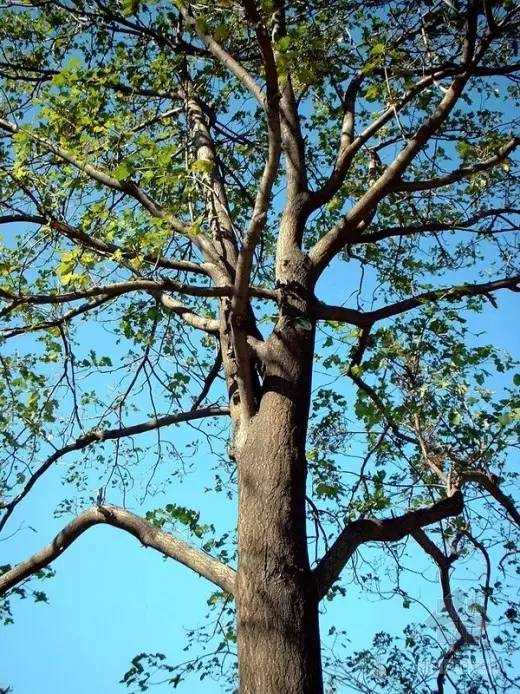30 species of commonly used deciduous trees
Deciduous trees have a short life span, and all their leaves fall off within a year. After all the old leaves fall off, they enter a dormant period. Generally, most deciduous trees are located in temperate climates. They flourish in summer and shed their leaves in winter. A few species can survive the winter with dead leaves. Today, I will introduce 30 common deciduous trees in landscaping.
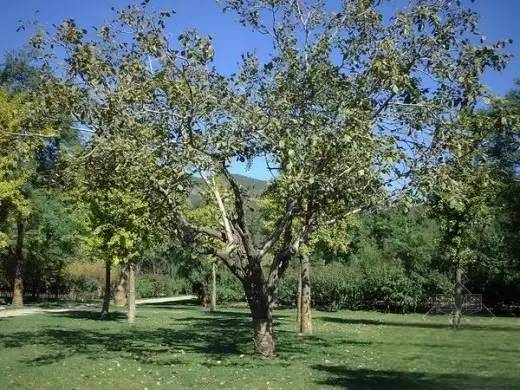
1. Walnut, Juglans genus, Juglandaceae
Scientific Name : Juglans regia
Identification points : Deciduous tree, up to 3-5m tall, with grayish white bark and shallow longitudinal fissures, lamellar pith of branches, and fine soft hairs at the tips of young branches; 2-year-old branches are often hairless.
Ecological habits : It likes light, is cold-resistant, has strong drought and disease resistance, can adapt to growing in a variety of soils, likes water and fertilizer, but is not strict on water and fertilizer. It is not suitable to prune after leaf fall and before germination, as sap flow is easy to occur.
Use in Gardens : The walnut tree has a majestic crown, a white trunk, lush branches and leaves, and covers the ground with green shade. It can be used to green roads in gardens and play a protective role.
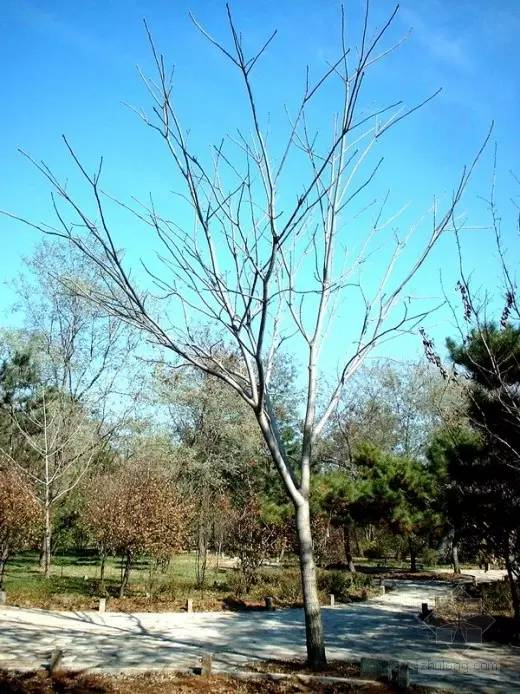
2. Juglans mandshurica, Juglandaceae
Scientific name : Juglans mandshurica Maxim.
Identification points : The tree can reach a height of more than 20 meters and a breast diameter of 70 centimeters. The bark is gray and shallowly fissured. The leaves are alternate and odd-pinnate. The flowering period is April-May, and the fruit ripens in August-September.
Ecological habits : It likes light. It is cold-resistant, but it is easy to dry out when there is dry wind. It is suitable for growing in valleys or lower parts of hillsides with deep humus, moisture and good drainage.
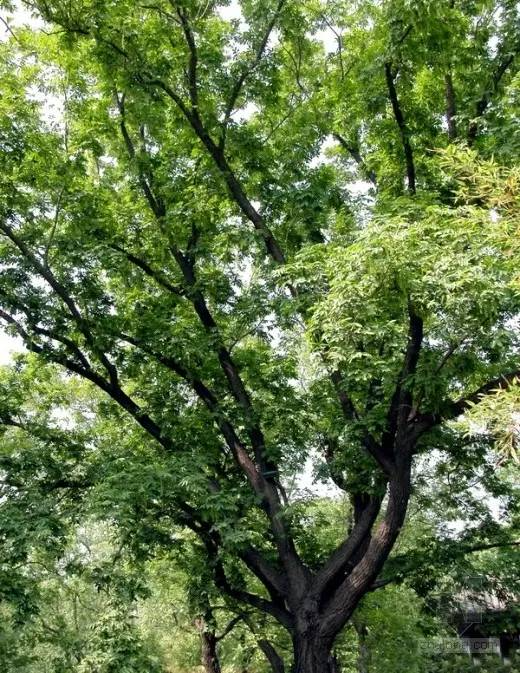
3. Maple, Juglans genus
学名:China Wingnut ,Chinese Winged Nut,Chinese Ash
Identification points : Up to 30 meters tall, with a breast diameter of 1 meter; the bark of young trees is smooth and light gray, and deeply fissured when old; the twigs are gray to dark brown with grayish-yellow lenticels; the buds are petiolate and densely covered with rust-brown shield-shaped glands. The flowering period is April-May, and the fruit ripening period is August-September.
Ecological habits : It is a light-loving tree species, not shade-tolerant, but tolerant to waterlogging, cold and drought. It has deep roots, with well-developed main and lateral roots, and grows well on both sides of deep and fertile riverbeds.
Garden use : With a broad crown, dense branches and leaves, rapid growth and a well-developed root system, it is a good greening tree species for low-lying wetlands on both sides of the riverbed. It can be used as a street tree, planted in groups or alone on lawns and slopes, and can form a certain landscape.
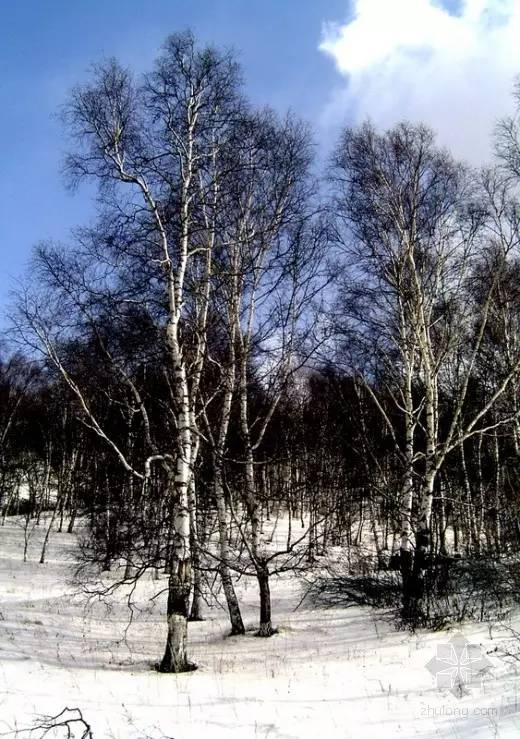
4. Birch, Betulaceae
Scientific name : Betula platyphylla Suk
Identification points : Up to 25m tall, 50cm diameter at breast height; oval crown, white bark, peeling off in papery layers, yellow lenticels. Thin twigs, reddish brown, hairless, covered with white wax birch layer. Leaves are triangular-ovate or rhombus-ovate.
Ecological habits : It likes light and is not shade-tolerant. It is cold-resistant. It has strong adaptability to soil and likes acidic soil. It can grow in swamps, dry sunny slopes and moist shady slopes.
Garden use : birch has luxuriant branches and leaves, and graceful posture, especially the straight trunk, white and elegant, which is very eye-catching. It is beautiful to plant alone or in clusters in gardens, lawns of parks, poolside, lakeside or in rows along the road. If planted in large areas on mountainous or hilly slopes, it can form a beautiful landscape forest.
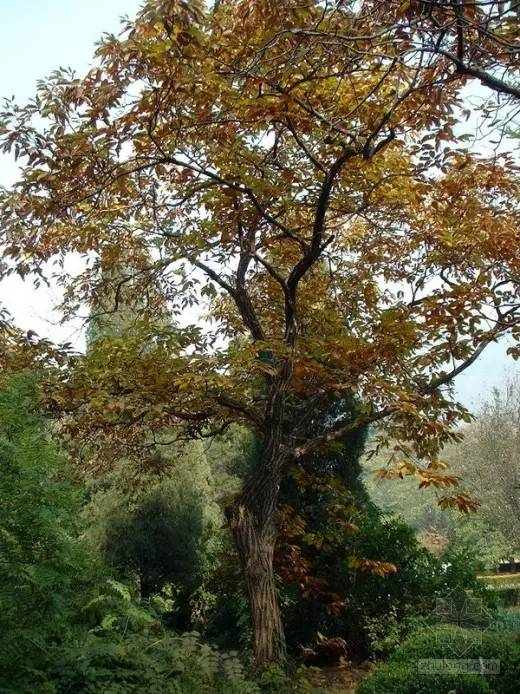
5. Chestnut, Fagaceae Castanea
Scientific name : Castanea mollissima
Key points for identification: Most chestnut species are deciduous trees 20-40 meters high, and only a few are shrubs. All chestnut trees produce edible nuts, with simple leaves, oval or oblong, 10-30 cm long, 4-10 cm wide, and bristly teeth on the edges. Monoecious, male flowers are erect catkins, and female flowers are single or several in the involucre. The nuts are enclosed in a densely thorny involucre, with a diameter of 5-11 cm, and one involucre contains 1-7 nuts. Flowering period is May to June; fruit ripening period is September to October.
Ecological habits : It likes light. Insufficient light will cause branches to die or fruit not to be produced. It is not very demanding on soil. It likes fertile, warm, well-drained sandy or loamy soil. It has strong resistance to harmful gases. It avoids stagnant water and heavy soil.
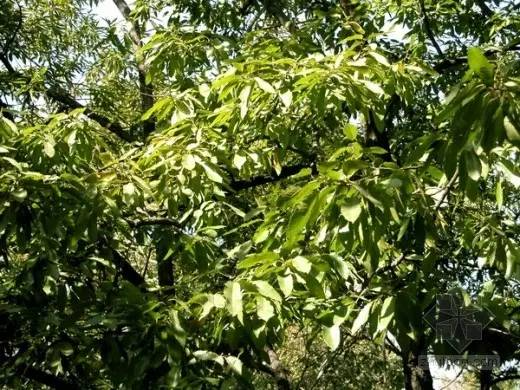
6. Cork oak, Fagaceae Quercus
Name : Quercus variabilis Blume.
Identification points: Deciduous tree, up to 25 meters tall; well-developed cork layer, deep longitudinal fissures on bark, dark gray. Leaves are alternate; broadly lanceolate, 8-15 cm long, 3-6 cm wide, gradually pointed at the apex, broadly cuneate at the base.
Ecological habits: It likes light and often grows on sunny slopes of mountains, but it is better for young trees to have side shade. It has strong adaptability to climate and soil. It can withstand low temperatures of -20℃.
Garden use : The trunk is straight, the branches are wide, the crown is majestic, and the shade is thick. In autumn, the leaves turn orange-brown, and the seasonal changes are obvious. It is a good ornamental tree species. It is suitable for single planting, planting in groups, or mixed with other trees. Because of its well-developed root system, strong adaptability, and non-flammable bark, it is also an excellent tree species for building windbreaks, water conservation forests, and shelterbelts.
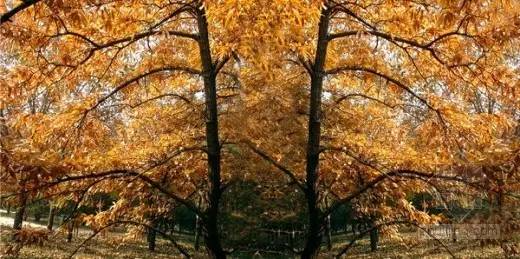
7. Quercus acutissima, Fagaceae
Name : Quercus acutissima Carruth.
Identification points : Deciduous tree, up to 25 meters tall; bark dark gray, shallowly cracked; young branches densely covered with pubescence, which later falls off. Leaves are elliptical and needle-shaped, 8-18 cm long, 3-4.5 cm wide, gradually pointed or acute at the apex, and rounded or broadly cuneate at the base.
Ecological habits : It is a light-loving tree species. It cannot grow under the canopy of a forest, but grows rapidly in mixed forests and dense forests, with a good trunk shape.
Garden use : This species has a tall tree shape, spreading crown, and lush shade. Because of its well-developed root system and strong adaptability, it can be used as a garden shade tree or street tree.
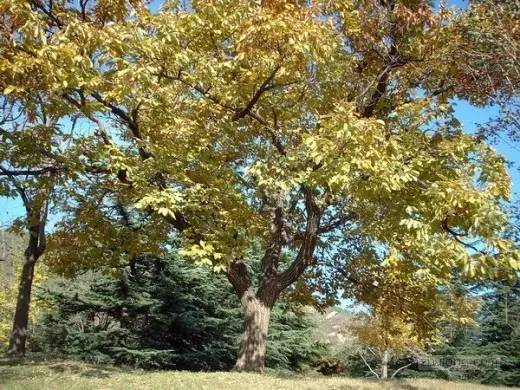
8. Quercus spp., Fagaceae
Scientific name : Quercus dentata Thunb.
Identification points : Deciduous tree
Ecological habits : It likes light and is a weak positive tree. It often grows in barren hills or mixed with other oaks, camphor trees, small-leaved elm, masson pine, cypress, and Chinese pine.
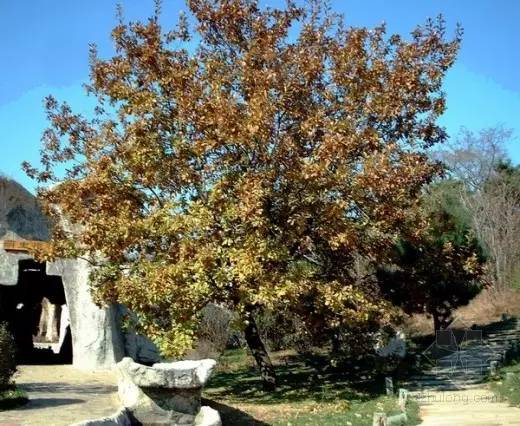
9. Quercus liaotungensis, Fagaceae
Scientific name : Quercus liaotungensis Koidz.
Identification points : 10-20m tall, leathery leaves, obovate to elliptical-obovate, 5-15cm long, 2.5-10cm wide. Solitary flowers, monoecious, catkins drooping, buds woody and bowl-shaped when mature. Nuts ovate. Positive species.
Ecological habits : likes warmth, is cold-resistant, drought-resistant and barren-resistant. It grows on sunny slopes, semi-sunny slopes and ridges of mountains.
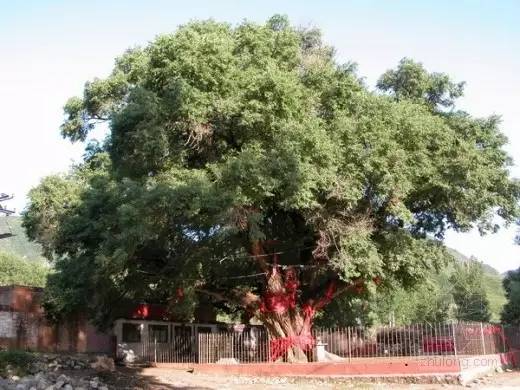
10. Elm, Ulmus genus
Scientific name : Ulmus pumila L.
Identification points : Up to 25 meters high, 1 meter in diameter at breast height, grows as a shrub in dry and barren land; the bark of young trees is smooth, gray-brown or light gray, while the bark of large trees is dark gray, with irregular deep longitudinal cracks and is rough.
Ecological habits : positive tree species, light-loving, drought-tolerant, cold-tolerant, barren-tolerant, not selective of soil, highly adaptable. Developed root system, strong wind resistance and soil retention.
Garden use : Elm has a straight trunk, tall tree shape, dense green shade, strong adaptability, and fast growth. It is an important tree species for urban greening. It is suitable for planting as a street tree, a garden shade tree, a shelterbelt, and "four sides" greening. In dry and cold land, it often appears as a shrub and is used as a hedge. Because its old stems and roots have strong germination power, they can be dug from the wild to make bonsai. In forestry, it is also one of the main tree species for creating windbreaks, soil and water conservation forests, and saline-alkali land afforestation.
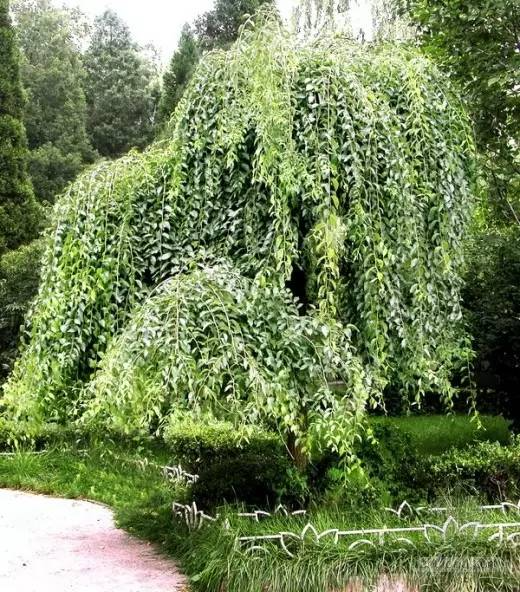
11. Elm, Ulmus spp., Ulmus spp.
Scientific Name : Ulmus pumila 'tenue'
Identification points: Deciduous small tree. Single leaves are alternate, elliptic narrow ovate or elliptic lanceolate, 2-9 cm long, oblique at the base, with single serrations on the leaf margin, and 9-16 pairs of lateral veins reaching the tip of the teeth.
Ecological habits : It likes light, is cold-resistant, drought-resistant, and likes fertile, moist and well-drained soil. It is not tolerant to waterlogging, but can tolerate drought, barrenness and saline-alkali soil. It has deep taproots, well-developed lateral roots, is wind-resistant, has strong soil-retaining ability, strong germination ability, and is resistant to pruning.
Garden use : The branches droop down, making the plant tower-shaped. Usually white elm is used for high-position grafting, and it is suitable to be arranged in pairs at the door or on both sides of the building entrance, or planted in rows beside the building or road.
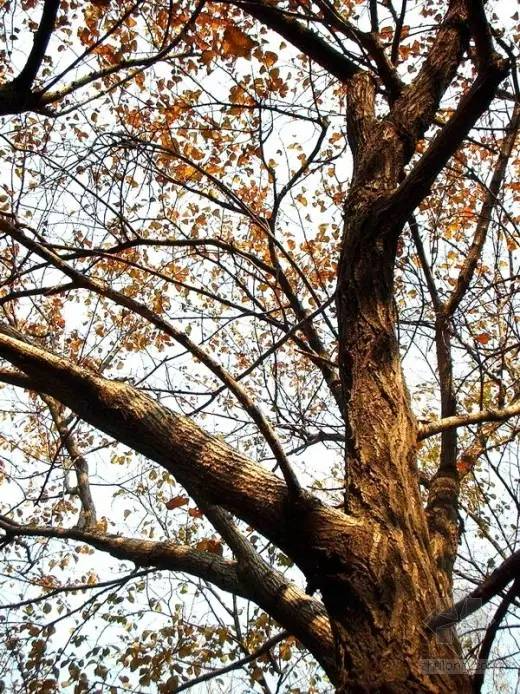
12. Elm, Ulmus macrocarpa
Scientific Name : Ulmus macrocarpa
Identification points : Deciduous tree. Up to 10m tall, 30m diameter at breast height. The crown is oblate. The bark is grayish black, and the twigs often have two regular cork wings. The leaves are obovate or elliptical, heavily serrated, coarse and thick, with short hard hairs. The samaras are large, with long reddish-brown hairs.
Ecological habits : It likes light, is cold-resistant, slightly tolerant to saline-alkali, and can grow in soil with a salt content of 0.16%. It is resistant to drought and barrenness, has a well-developed root system, strong sprouting ability, and a long lifespan. The leaf color turns reddish brown in late autumn, and it is one of the autumn-colored leaf tree species in the north. The material is better than that of white elm.
Garden use : With a large crown and dense shade, the tree is tall and has strong adaptability. It is a popular tree species in urban lawns and hillsides. It is often densely planted as a hedge. It is one of the four famous street trees in the world. It is planted in rows on roads and sidewalks. It is planted in groups on lawns and hillsides. It is often densely planted as a hedge. It is the main tree species for greening the "four sides" of rural areas in the north, and is also an important tree species for windbreak and sand fixation, soil and water conservation, and afforestation in saline-alkali land.
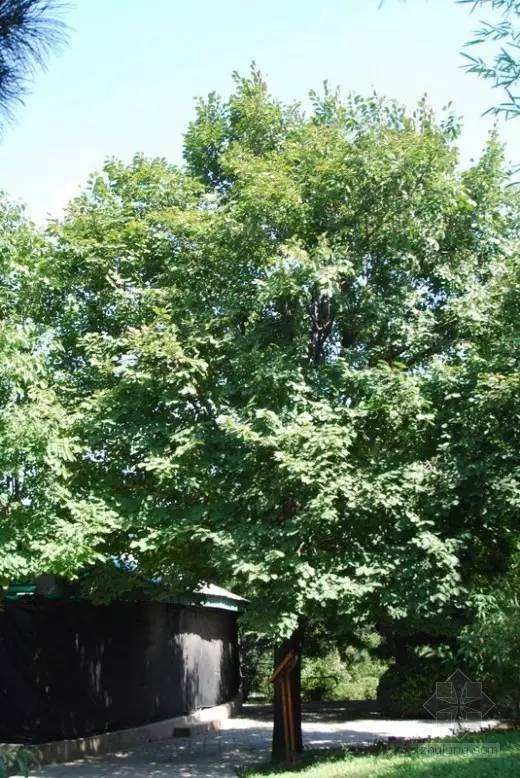
13. Hackberry, Ulmaceae
Scientific Name : Celtis sinensis
Identification points : Deciduous tree, up to 20 meters tall; bark is gray-brown, smooth and uncracked, branches are flat. Branchlets of the current year are densely hairy. Leaves are thick, broadly ovate or rounded, with serrations on the middle and upper edges; three-veined, with less than six pairs of lateral veins that do not reach the leaf margins, leaves are glabrous, and veins are sparsely pubescent along the back.
Ecological habits : It likes light and tolerates shade. It likes rich, moist and loose soil, and tolerates drought and barrenness, mild salinity and water. It has strong adaptability, deep roots, strong germination ability, and wind resistance. It tolerates smoke and dust, and pollution. It grows fast and has a long lifespan.
Garden use : With a wide and round crown and rich shade, the Chinese hackberry is most suitable for use as a shade tree in parks and gardens. It can also be planted as a street tree on streets and highways. It can be used in urban residential areas, schools, factories and mines, street green spaces, and rural "four sides" greening. It is also a windbreak and embankment strengthening tree in river network areas. It can also be used as a village landscape material.
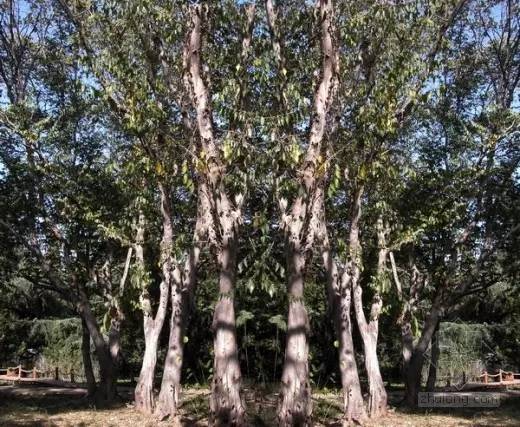
14. Pterocarpus truncatus, Pterocarpus truncatus
Scientific name : Pteroceltis tatarinowii Maxim.
Identification points: Deciduous tree, up to 20 meters high; bark is light gray, smooth when young, and cracked into long flakes when old, revealing gray-green inner bark after peeling; the trunk is often uneven and not round; twigs are chestnut brown or gray-brown, thin, glabrous or with soft hairs; winter buds are oval, reddish-brown, and hairy.
Ecological habits: It is a positive tree species, often growing at the foot of mountains, forest edges, valleys, river beaches, stream sides and crevices in cliffs, forming small pure forests or mixed with other tree species.
Garden use : Pteris truncatum is a unique monospecies, and has academic value in studying the systematic development of the Ulmaceae family. The bark and branch bark fibers are high-quality raw materials for making Xuan paper, which is famous both at home and abroad; the wood is solid, dense, tough, and resistant to damage, and is used for furniture, farm tools, drawing boards, and joinery. It is used as a afforestation species in limestone mountains.
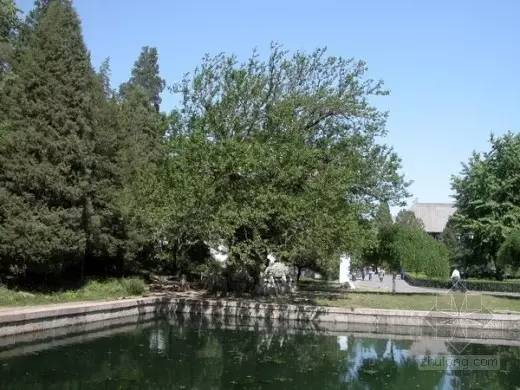
15. Mulberry, Moraceae, Morus
Scientific name : Morus alba L
Identification points: Deciduous tree, mulberry leaves are oval, which are the feed for silkworms. Deciduous tree, 16m high, 1m diameter at breast height. The crown is obovate.
Ecological habits : It likes light and has strong adaptability to climate and soil. It is cold-resistant and can withstand temperatures as low as -40°C, drought-resistant, and water-resistant.
Garden use : Mulberry trees have full crowns, dense branches and leaves, golden autumn leaves, strong adaptability, and easy management. They are pioneer tree species for urban greening. They are suitable for solitary planting as garden shade trees, and they should also be arranged with shade-loving flower shrubs, tree altars, tree groves, or mixed with other tree species for landscape forests. The fruit can attract birds and form a natural landscape with birdsong and flowers. It can be used in new residential villages and factory green spaces. It is the main tree species for rural "four sides" greening. Mulberry leaves can be used to raise silkworms. Silkworms like to eat tender leaves. Tender leaves feel rough to the touch, while old leaves are soft.
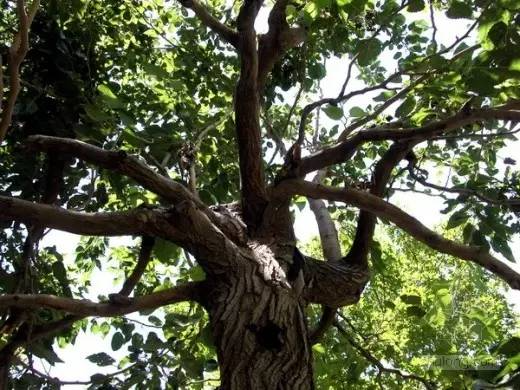
16. Long Mulberry, Moraceae, Morus
Scientific Name : Morus alba Tortuosa
Identification points: Deciduous tree, bark is yellow-brown and shallowly cracked. The branches are twisted in a dragon-like shape. The young branches are hairy or smooth. The leaves are ovate to oval, large and shiny.
Ecological habits : like light, young trees are slightly shade-tolerant, like warmth and humidity. Cold-resistant, can grow at low temperatures of -40 degrees.
Gardening use : The branches of the dragon mulberry tree are twisted like a swimming dragon, with a wide crown and dense branches and leaves. The leaves turn yellow in autumn, which is quite beautiful. It can be cultivated into a medium-trunk tree, a bushy tree, or a tall tree. It is suitable for planting in patches, rows, scattered plants, or solitary plants. It is resistant to smoke and toxic gases and is suitable for greening the surrounding areas of urban areas and industrial and mining areas. Mulberry leaves can be used to raise silkworms. Branches can be used as bonsai and flower arrangement materials. The whole plant is used as medicine.
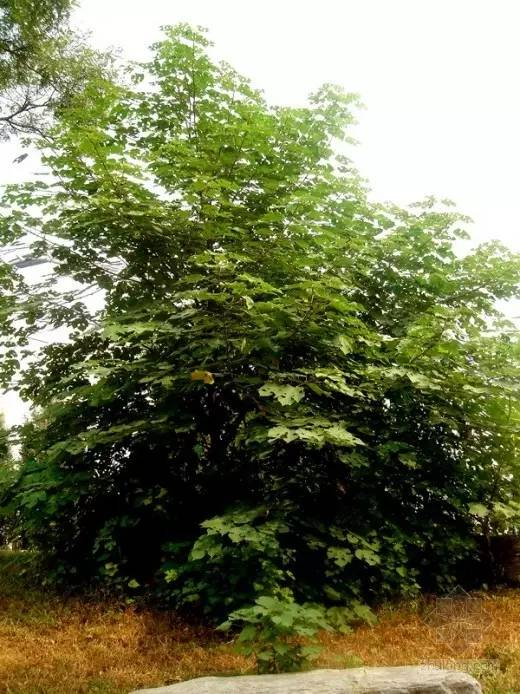
17. Broussonetia papyrifera, Moraceae
Scientific name : Papermulberry
Identification points : Deciduous tree, up to 16 meters tall; open crown, ovate to broadly ovate; smooth bark, light gray or gray-brown, not easy to crack, the whole plant contains latex. Single leaves alternate.
Ecological habits : A strong sun-loving tree species with strong adaptability and resistance to adversity.
Gardening use : It can be used as a greening tree species for wasteland, remote areas and factories with serious pollution. It can also be used as a street tree and papermaking.
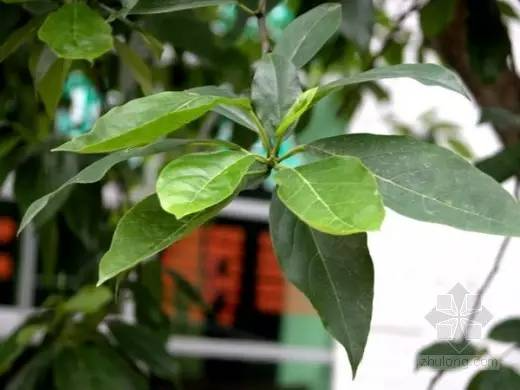
18. Cudrania, Moraceae
Scientific Name : Cudrania tricuspidata (Carr.) Bur
Identification points : Deciduous tree, up to 8 meters tall, with light gray bark that peels off in irregular flakes; young branches have fine hairs that fall off later, with hard thorns 5-30 mm long. Leaves are ovate or obovate.
Ecological habits : It likes light and tolerates shade. It is cold-resistant and likes calcareous soil. It tolerates drought and barrenness. It grows mostly in the cracks of rocks on mountain ridges and has strong adaptability.
Garden use : With beautiful leaves and fruits, it is highly adaptable and can be used as a shade tree or hedge in the corners of parks, shaded areas, and street green spaces. It is easy to propagate and has a wide range of economic uses. It is a pioneer tree species for greening wastelands and conserving water and soil in scenic areas.
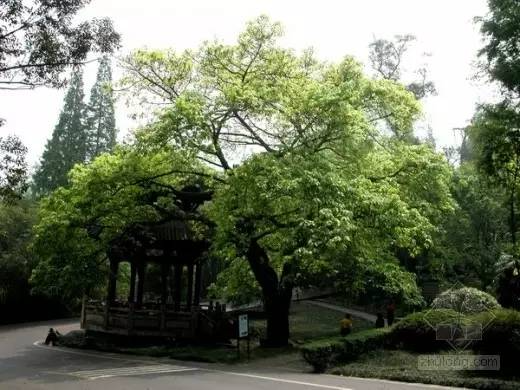
19. Banyan tree, Moraceae Ficus
Scientific name : Ficus virens Ait.var.sublanceolata(Miq.)Corner[F.lacor sensu auct.non Buch. -Ham.]
Identification points : Deciduous tree, 15-20m high. Buttress roots extend to dozens of meters, prop roots form the trunk, chest circumference reaches 3-5m. Leaves are alternate; petiole is 2.5-5cm long; stipules are broadly ovate.
Ecological habits : It likes light, is drought-resistant, can tolerate barrenness, has aerial roots, and has a particularly strong adaptability.
Garden use : In garden applications, it is suitable for planting in park lakeside, lawn, river bank, scenic area, solitary or group planting to create landscaping, providing a place for people to relax and cool off, and can also be used as a street tree.
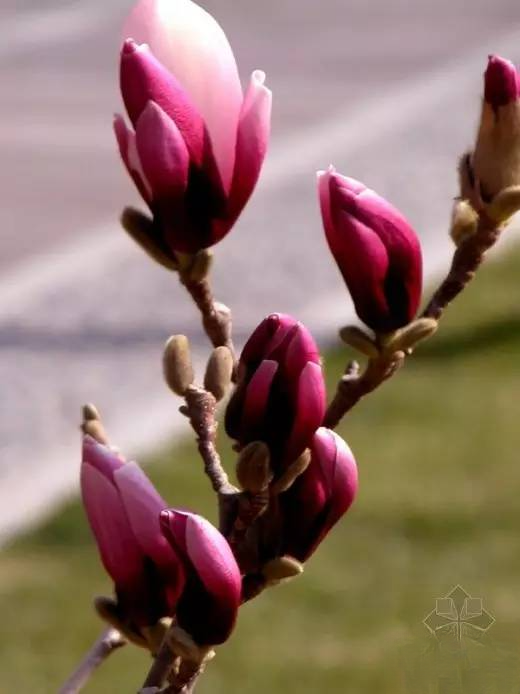
20. Purple Magnolia, Magnoliaceae
Scientific Name : Magnolia liliiflora
Identification points : Deciduous tree, up to 3 meters tall, often growing in clumps, with gray-brown bark and green-purple or light brown-purple twigs. Leaves are elliptical-obovate or obovate.
Ecological habits : It likes warm, humid and sunny environment, is relatively cold-resistant, but not drought-resistant and saline-alkali-resistant, is afraid of waterlogging, and requires fertile, well-drained sandy loam.
Use in gardens : Purple magnolia is a famous early spring ornamental flower. When it blooms in early spring, the tree is full of purple-red flowers, which are graceful and elegant, with unique charm. It is suitable for planting in the front and back yards of classical gardens, and can also be planted alone or scattered in small courtyards.
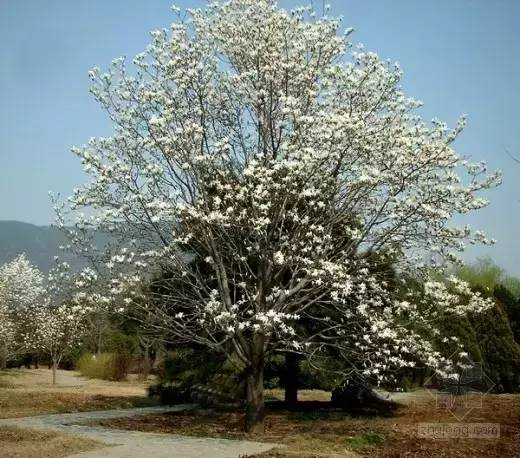
21. Magnolia, Magnolia genus
Scientific Name : Magnolia denudata
Identification points : Deciduous tree, usually 2-5 meters tall or up to 15 meters tall. Winter buds densely covered with light gray-green hairs. Leaves alternate. Flowers bloom before leaves, erect, bell-shaped, fragrant, jasper-white, sometimes with a reddish base. Aggregate fruit, heart-shaped seeds, black.
Ecological habits : It likes warm, sunny, moist and well-drained places, and requires fertile soil without water accumulation. It has strong cold resistance and can safely overwinter at -20℃.
Garden use : Magnolia blooms before leaves, and its flowers are white, beautiful and fragrant. When it blooms in early spring, it looks like a sea of snow and clouds, which is spectacular. In ancient times, it was often placed in front of the hall and back of the house, and was called "Yulan Hall". It can also be planted on the roadside of the garden, in the corner of the lawn, in front of and behind the pavilion, inside and outside the window, and on both sides of the cave door. It can be planted alone, in pairs, in clusters or in groups. It has strong resistance to toxic gases such as sulfur dioxide and chlorine, and can be cultivated in areas with severe air pollution.
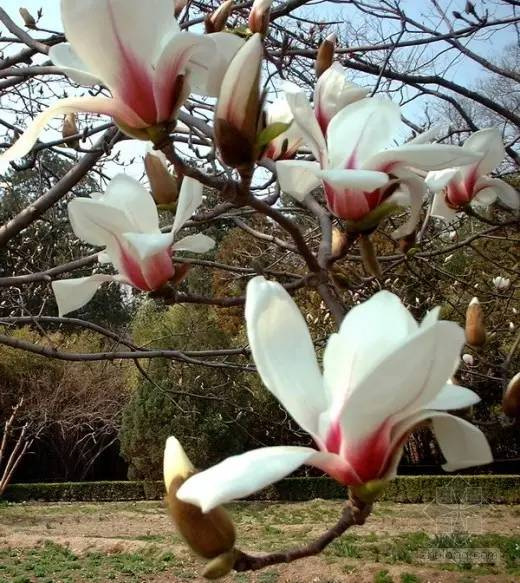
22. Magnolia grandiflora, Magnoliaceae
Scientific name : Magnolia × soulangeana
Identification points : Deciduous tree, a hybrid of magnolia and yulan. The shape is between the two. The flowers are lavender on the outside, white on the inside, and fragrant. The leaves are obovate or broadly obovate, with a wide round tip and gradually narrowed to a wedge shape below 1/3. The flowers are large and fragrant, with 6 petals, lavender on the outside and white on the inside, and 3 sepals, petal-shaped and slightly short. The flowering period is early spring.
Ecological habits : likes sunshine and warm and humid climate. Very sensitive to temperature, the flowering period in the north and south can differ by 4-5 months
Garden use : Magnolia ericaceae has large and colorful flowers and high ornamental value. It is an excellent flower for urban greening. It is widely used for solitary ornamental in parks, green spaces and gardens. Aromatic extracts can be extracted from its bark, leaves and flowers. It is widely cultivated in courtyards at home and abroad.
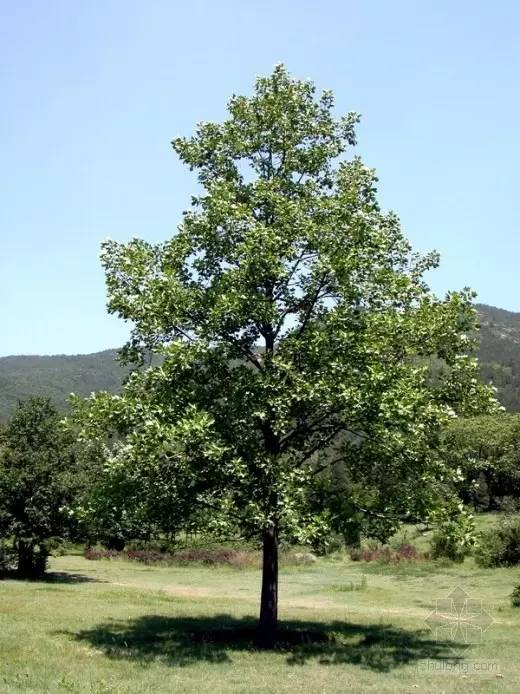
23. Liriodendron, Magnoliaceae
Scientific Name : Liriodendron chinensis (Hemsl.) Sarg
Identification points : Deciduous tree, up to 40 meters tall, with a breast diameter of more than 1 meter. Leaves are alternate, 6-22 cm long, 5-19 cm wide, often with 2 lobes on each side, pink-white on the back; petiole 4-8 cm long.
Ecological habits : It likes light and mild and humid climate, has a certain degree of cold resistance, and can withstand low temperatures of minus 15 degrees Celsius without being harmed. It can spend the winter outdoors under good microclimate conditions in Beijing.
Garden use : With a straight tree shape and peculiar leaf shape, the Chinese tulip tree is a beautiful shade tree and street tree species. It is one of the five major street tree species in the world, along with the sycamore, linden, ginkgo, and horse chestnut. The flowers are light yellow-green, beautiful but not gaudy, and are best planted on lawns in quiet rest areas in gardens. The autumn leaves are yellow and very beautiful. They can be planted alone or in groups. In the Jiangnan natural scenic area, they can be planted in mixed forests with Schima superba, Hickory, and Chestnut. Because its flower shape resembles a tulip, it is called the "Chinese Tulip Tree". It is a very precious bonsai ornamental plant and is very rare. It is resistant to toxic gases such as sulfur dioxide and can be planted in areas with severe air pollution.
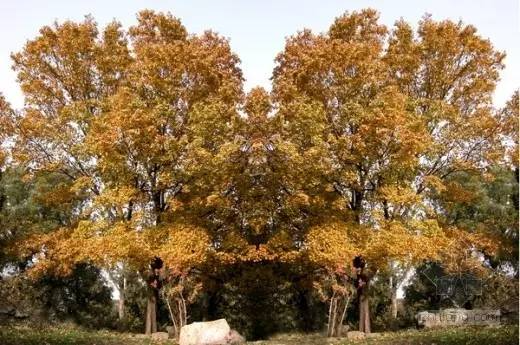
24. Liquidambar formosana, Hamamelidaceae
Scientific Name : Liquidambar formosana Hance
Identification points : Deciduous tree, up to 40m tall, with pubescent twigs. Leaves are alternate, broadly ovate in outline, palmately 3-lobed, with serrated edges, 3-5 palmate veins, and red stipules that fall off early.
Ecological habits : It likes sunlight and grows mostly in plains, near villages, and in secondary forests on low mountains. It is often a dominant species in secondary forests on Hainan Island. It is fire-resistant and has a strong germination ability.
Garden use : Liquidambar is very suitable for creating landscape forests in low mountains and hilly areas in the south. The towering trees in moist and fertile soil are very magnificent. It can also be planted as a shade tree in the garden. When the temperature difference between day and night increases in autumn, the leaves turn red, purple, orange-red, etc., adding autumn colors to the garden. It can be planted alone or in clusters on the grassland, or mixed with other trees on the hillside and poolside. If planted with evergreen trees, the red and green in autumn will be particularly beautiful. Lu You has a poem that says "several red maple trees reflect the green cypress." Because Liquidambar has strong fire resistance and resistance to toxic gases, it can be used for greening factories and mining areas. It is a good shade tree species in the garden, especially in the south, where the autumn scenery is mainly the red leaves of Liquidambar. It is also used as a street tree.
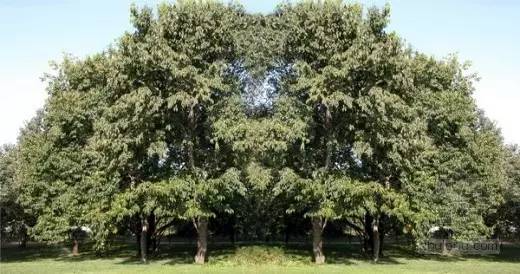
25. Eucommia ulmoides, Eucommia genus, Eucommia family
Scientific Name : Eucommia ulmoides Oliver
Identification points : Deciduous tree, up to 20 meters tall, 50 cm diameter at breast height. Spherical crown. Dark grey bark, branches with flaky pith, silvery white gum filaments on broken parts of the tree. Smooth twigs, no terminal buds.
Ecological habits : It likes plenty of sunshine, mild and humid climate, is cold-resistant, and has no strict requirements on soil. It can be planted on hills and plains, and can also be cultivated on scattered land or around the edges.
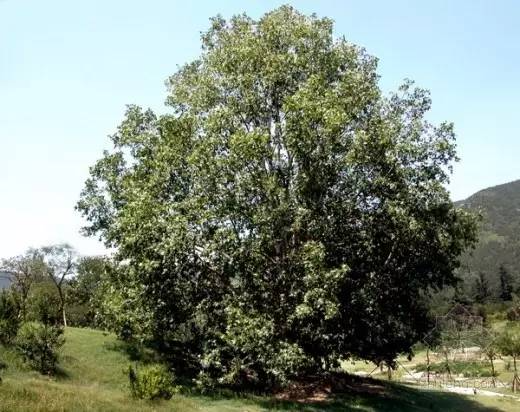
26. Platanus, Platanaceae
Scientific name : Platanus ×acerifolia (Ait.) Willd.
Identification points : Deciduous tree, up to 35 meters tall. Branches spread out, with a broad, long oval crown. Bark is gray-green or gray-white, peeling off in irregular flakes, and then becomes pink-green and smooth. Buds under the petiole. Single leaves are alternate, large, triangular, 9-15 cm long, 9-17 cm wide, and 3-5 palmately divided.
Ecological habits : It likes light. It likes moist and warm climates and is relatively cold-resistant. It is suitable for growing in slightly acidic or neutral, well-drained soils. Although it can grow in slightly alkaline soils, it is prone to yellowing.
Use in gardens : The sycamore tree has a majestic shape and dense branches and leaves. It is a world-renowned excellent garden shade tree and street tree, and is known as the "King of Street Trees".
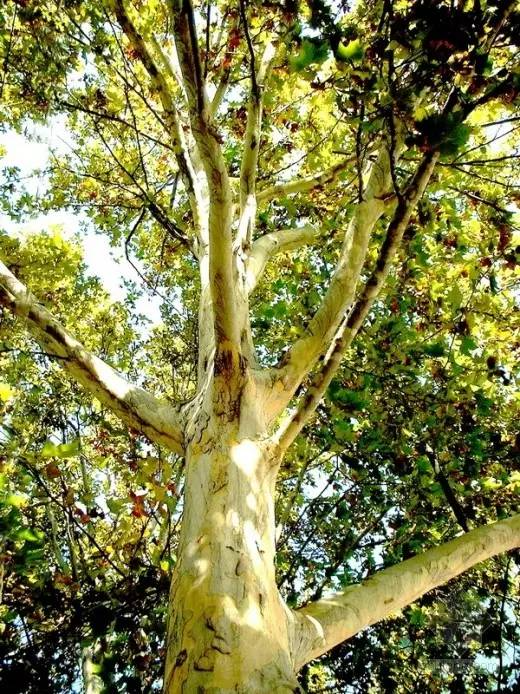
27. French plane tree, Platanus spp.
Scientific name : Platanus ×acerifolia
Identification points : Deciduous tree, up to 30m tall, dark grey bark, peeling off in thin sheets, greenish white inner bark. Young branches covered with yellowish brown star-shaped hairs. Leaves 8-16cm long, 9-18cm wide, 5-7 deep lobes to the middle or below, narrow and long lobes, covered with greyish yellow star-shaped hairs when young, which fall off later.
Ecological habits : It likes light. It likes moist and warm climates and is relatively cold-resistant. It is suitable for growing in slightly acidic or neutral soil with good drainage. Although it can grow in slightly alkaline soil, it is prone to yellowing. The root system is shallow.
Garden use: It is a world-renowned excellent garden shade tree and street tree. It has strong adaptability and is resistant to pruning and shaping. It is an excellent street tree species and is widely used in urban greening. In the garden, it is planted alone on the lawn or open space, and is planted on both sides of the street. It is particularly majestic and spectacular. Because it has strong resistance to many toxic gases and can absorb harmful gases, it is quite suitable for greening neighborhoods, squares, and campuses.
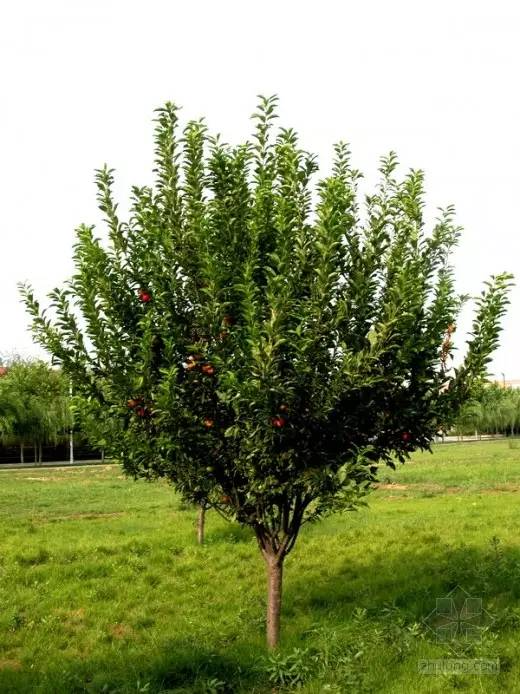
28. Plum, Rosaceae
Scientific name : Prunus salicina Lindl.
Identification points : Deciduous tree, 9-12 meters tall, with a broad spherical crown; the bark is gray-brown and undulating; the twigs of the plum tree are smooth, hairless, gray-green and shiny
Ecological habits : Strong adaptability, not strict on soil, rapid growth, early fruiting period, high yield. Strong resistance to gray rot, fruit storage resistance, early flowering. Sometimes susceptible to early frost in cold areas.
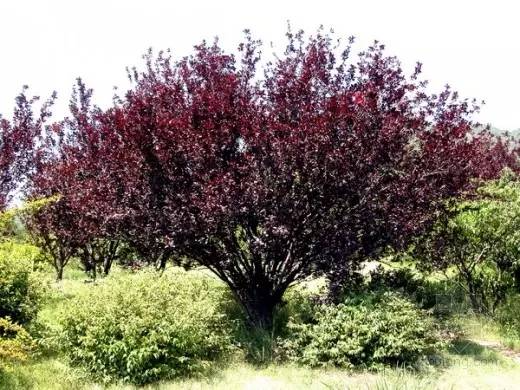
29. Purple-leaf plum, Rosaceae, Prunus
Scientific Name : Prunus ceraifera cv. Pissardii
Identification points : deciduous tree, purple-gray bark, light reddish brown twigs, smooth and hairless trunk. Single leaves are alternate, ovate or oblong-lanceolate, 4.5-6 cm long, 2-4 cm wide, short-pointed at the tip, cuneate at the base, with sharp serrations at the margin, 5-8 pairs of pinnate veins, glabrous on both sides or with hairs in the vein axils on the back, dark green or purple-red in color, and smooth petioles with few glands.
Ecological habits : It likes light and tolerates shade, is cold-resistant, and has strong adaptability. It is most favorable to warm and humid climate and well-drained sandy loam. It is afraid of saline-alkali and waterlogging. It has shallow roots, strong sprouting ability, and has a certain resistance to harmful gases.
Garden use : Red leaf plum has a wide range of uses in garden greening. Its strong adaptability allows it to be used in many places. It can be planted in streets, flower beds, around buildings, on both sides of roads, etc. It can be planted alone around the square and on the central lawn. Red leaf plum is also a commonly used garden ornamental tree species. Red leaf plum is very clean during its growth period and does not produce growth garbage. The greening effect is visible in the same year, the effect is fast, and the landscape cycle is short. The pollution resistance of red leaf plum makes it safe to use in large quantities in road greening and highway greening.
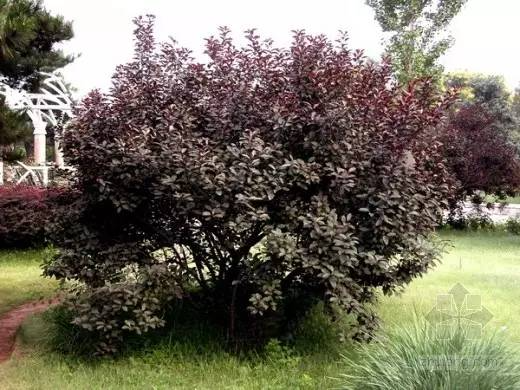
30. Purple-leaf dwarf cherry, Rosaceae, Prunus
Scientific Name : Prunus×cistena
Identification points : Deciduous tree, plant height 180cm-250cm, crown width 150cm-280cm, branches are purple-brown when young, usually hairless, old branches have lenticels, distributed throughout the branches. Single leaves are alternate, long ovate or ovate-long elliptical, 4cm-8cm long, gradually pointed at the tip, broadly cuneate at the base, with irregular fine blunt teeth on the leaf margin, leaves are purple-red or dark purple-red, and the back of the leaves is darker purple-red.
Ecological habits : It likes light, has strong cold resistance and disease resistance. Purple-leaf dwarf cherry has good ornamental effect, grows slowly, is easy to reproduce, and is resistant to pruning.
Garden use : It is used as a sub-tree or even shrub, and is best used as a high-position color ribbon in garden landscaping. Due to its bright leaf color and beautiful plant shape, it has ideal ornamental effects whether planted alone or in clusters, and can even be potted or used in bonsai making. Because it can withstand strong pruning and the more it is pruned, the brighter the leaf color, it is an excellent material for making hedges, color ribbons, color balls, etc.
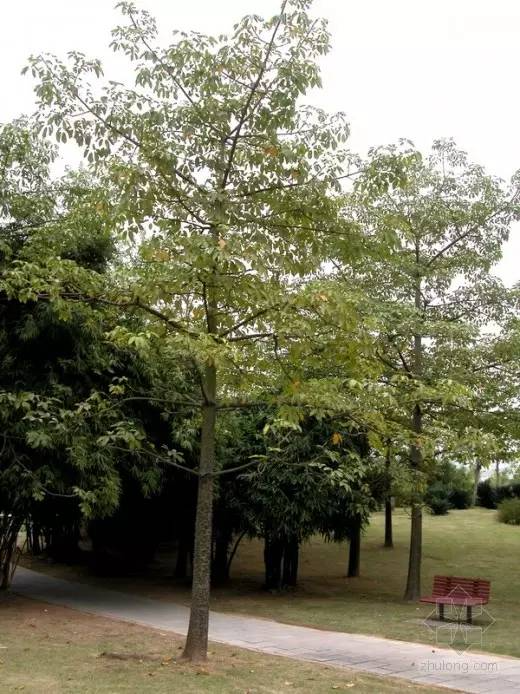
Kapok Tree
